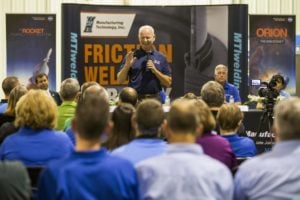When NASA launches its next mission taking astronauts to the moon and then to Mars for deep space exploration, Indiana will have had a hand in making that happen.
At least 36 companies from Indiana, including a handful from the South Bend area, are among the roughly 3,800 suppliers nationwide that will equip NASA's latest Orion mission, Artemis 1. The space agency plans to return to the moon by 2024 and embark on long-term lunar exploration by 2028.
Tube Form Solutions of Elkhart provided NASA with a CNC tube-bending machine that the agency is likely using to bend plumbing, conduits, and other items to support its mission to get back to the moon.
The company typically provides precision tube bending equipment to the aerospace, automotive and furniture industries, but it's a special source of pride being involved in the NASA project, said Mike Thomas, president of Tube Form, which employs about 65 at two plants in Elkhart.
"It does make it special", he said.
Other area businesses involved in the effort include Damping Technologies of Mishawaka, which provides noise and vibration control solutions for the aerospace, automotive, and consumer products industries, and Imagineering Enterprises of South Bend, which provides parts coating and testing services to the aerospace and automotive industries, and Pei-Genesis, which makes cables and connectors.
The main companies contracting with NASA are those you would expect.
Lockheed Martin is working on Orion, which will be able to take astronauts to multiple destinations in space.
Boeing is the lead for the rocket and launch system which will transport crew members and support systems into deep space.
Aerojet Rocketdyne is responsible for 25 engines.
Northrop Grumman is handling the solid rocket boosters, said Kathryn Hambleton, a public affairs officer at NASA's headquarters.
"Each of those companies has many suppliers across the country", she said. "And the suppliers list includes all the suppliers and vendors that work underneath those companies."
The list was published in January and has not been updated to reflect companies that have changed hands or moved.
"It's really nice to be able to be part of that research," said Scott Courts, a physicist and applications scientist at Lake Shore Cryotronics in Westerville, Ohio. "It's kind of cool to think that the parts that I handle, the parts that I inspect, that I've tested, are going to be in space for the next 30 years where they're orbiting Saturn or Jupiter.â€
Lake Shore Cyrotronics is building the Cernox temperature sensor. The gold-wired connectors inside the sensor are thinner in diameter than a strand of human hair. But the tiny sensing element made of copper, gold and ceramics can withstand temperatures ranging from minus-458 degrees Fahrenheit to plus-300 degrees.
Major budget
The fiscal year 2020 budget was amended to provide an increase of $1.6 billion above the president's initial $21 billion budget request, with no money taken from existing NASA programs, to bolster deep-space exploration.
NASA plans to use $1 billion to accelerate commercial partnerships, and another $651 million to complete the Space Launch System and Orion to support a 2024 moon landing.
South Pole before astronauts arrive, according to NASA's website.
The states with the largest number of companies supplying materials for the mission include more than 700 in California, 400-plus in Florida, more than 250 in Colorado, and nearly that amount in Texas.
"We're going to utilize the resources of the moon in order to learn how to live and work on another world", said NASA Administrator Jim Bridenstine, who spoke to reporters during a tour at NASA's Glenn Research Center facility in Sandusky, Ohio last month.
“What does that mean? That means we're going to use the water-ice. About 10 years ago, we learned that there's hundreds of millions of tons of water-ice in the South Pole of the moon. That water-ice represents air to breathe, it represents water to drink and it also represents rocket fuel, hydrogen and oxygen is the same rocket fuel that powers the space shuttles.
"It's the same rocket fuel that will power the Space Launch System rocket, which is the largest most powerful rocket ever developed", Bridenstine said.
The system is the size of a 38-story building and will produce 8.8 million pounds of thrust at launch, according to Boeing's website.
NASA is gearing up to put the next man and first woman on the moon within five years.

